Apple 15-inch MacBook Pro (Late 2011) Review
by Anand Lal Shimpi on November 17, 2011 5:10 PM EST- Posted in
- Mac
- Apple
- Intel
- MacBook Pro
- Sandy Bridge
- Laptops
Display Quality
The display hasn't changed since earlier this year, although this is the first 15-inch 2011 MacBook Pro that I've tested with the standard resolution (1440 x 900), glossy panel. Aesthetically I prefer this panel (I'm the rare case that isn't bothered by gloss) and the lower resolution is easier on my eyes, but for productivity I do feel the 1680 x 1050 upgrade is worth it. If this is going to be a workhorse, and you have good eyesight, get the high-res version.
As always, Apple calibrates its panels at the factory. Note the out-of-the-box white point across the 11-inch MacBook Air, 13-inch MacBook Air and 15-inch MacBook Pro:
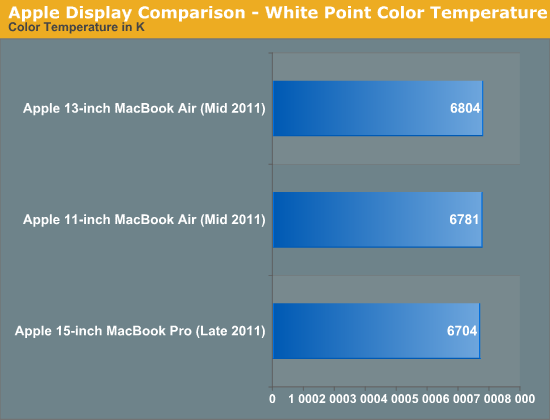
Apple wants to deliver as consistent of an experience as possible across its product line. While the Air models still don't have quite as high quality a panel as the Pro, at least there aren't any wide variations in what constitutes white on these panels.
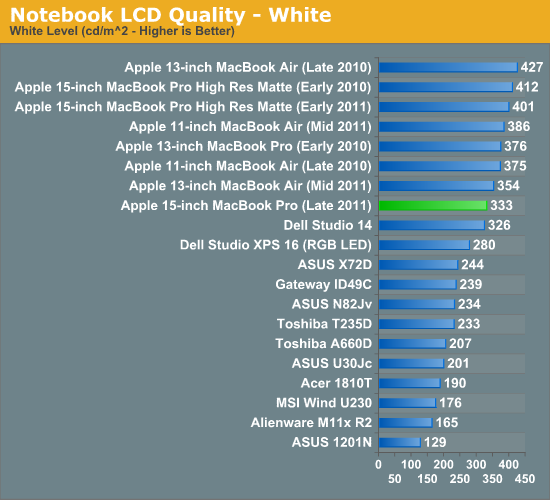
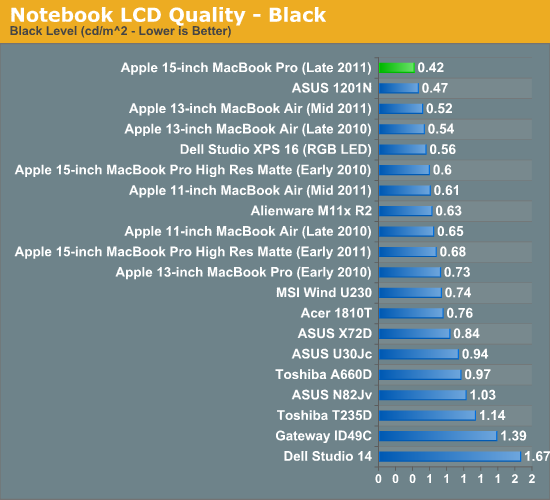
Brightness is down a bit compared to the high-res panel we looked at earlier this year, but so are black levels. The combination of the two actually results in a slightly higher contrast ratio than what we measured on the early 2011 models. In practice the panel looks just as good and seems to get just as blindingly bright as my personal 15-inch.
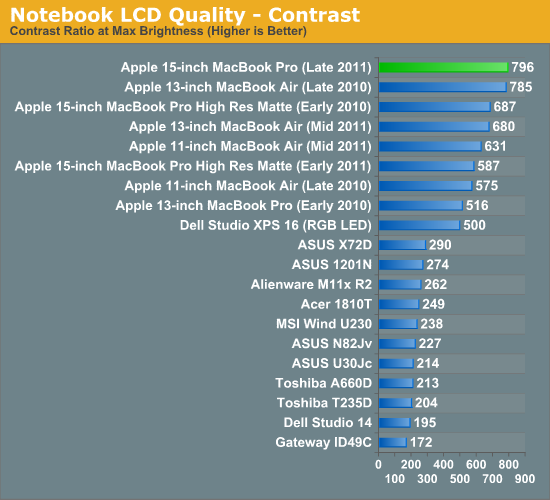
Color quality and gamut are virtually identical as well, no surprises here:
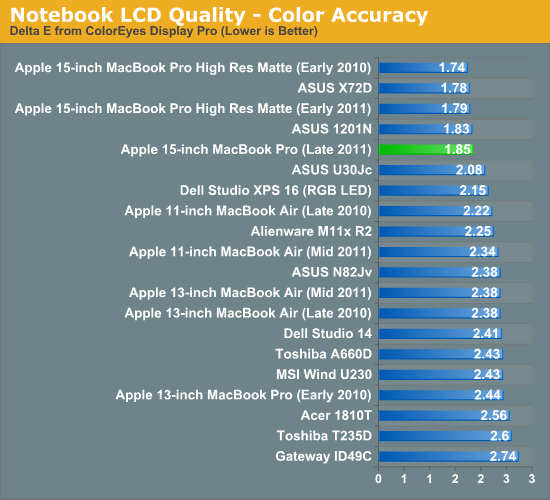

Hard Drive
The more traditional Macs (MBP, Mac Pro, iMac) continue to ship with mechanical hard drives by default, the late 2011 update is no different. My review sample came with a 5400RPM Toshiba MK5064GSXF. The drive features two 320GB platters (obviously not all in use for the 500GB capacity), and an 8MB cache.
All of my personal systems use SSDs and in testing the new MBP with a hard drive I can only say that the move back is more painful than ever. It's most noticeable when multitasking. Installing applications while browsing the web and copying files just seems to slow to a crawl compared to my SSD equipped MacBook Pro. If you're going to buy any new machine, especially if you're paying top dollar for something you expect to feel fast, you definitely need an SSD.

The good news is Apple's SSD pricing isn't horribly unreasonable, at least at the beginning. For $200 you can upgrade the 15-inch MacBook Pro to a 128GB drive (most likely a 3Gbps Samsung based SSD). It's when you look at the 256GB or larger drives that you're probably better off buying your own. You can buy a 256GB Crucial m4 for under $400 today, and a 240GB Vertex 3 will set you back around $460. Both options are cheaper (and faster) than Apple's $600 256GB upgrade. If you get the high-end 15-inch MBP model however, the upgrade prices drop by $100 - making the Apple route much more cost competitive. You don't get the same performance you would from an aftermarket drive, but with less headaches and potential for issues it's possibly a better route.
The 512GB drives are most definitely not a bargain from Apple. To equip a 15-inch MBP with a 512GB SSD, Apple wants $1200. You're much better off buying a 512GB Samsung SSD 830 for under $800 and pocketing the difference.
| Apple SSD Upgrade Pricing | |||||
| 128GB | 256GB | 512GB | |||
| 13-inch 2011 MacBook Pro | $200 | $600 | $1200 | ||
| 13-inch 2011 MacBook Pro (high end) | $100 | $500 | $1100 | ||
| 15-inch 2011 MacBook Pro | $200 | $600 | $1200 | ||
| 15-inch 2011 MacBook Pro (high end) | $100 | $500 | $1100 | ||
| 17-inch 2011 MacBook Pro | $100 | $500 | $1100 | ||
What aftermarket SSD should you buy? If you want to play it safe and hang on to TRIM support, go with Apple. Ever since I've been reviewed SSDs however I've run aftermarket SSDs in my Macs, mostly without any major issues. I can vouch for the Intel SSD 510, Samsung SSD 830 and OCZ Vertex 3. At one point or another I've used all of them in my 2011 MacBook Pro. My current setup is a Samsung 830 in the primary drive bay and an Intel SSD 510 in place of my optical drive, the combination works wonderfully.
Still Great WiFi
Apple continues to quietly focus on delivering excellent WiFi performance with the MacBook Pro. In the late 2011 models WiFi is still powered by Broadcom's BCM4331 3x3 solution. A quick test with a 3rd generation Time Capsule showed us peak transfer rates of 154Mbps, in line with what we've seen with the first generation Sandy Bridge MacBook Pro.

Despite Apple's move to Bluetooth 4.0 support on some of its other platforms, the MacBook Pro remains at 2.1 with the same BCM2070 controller.
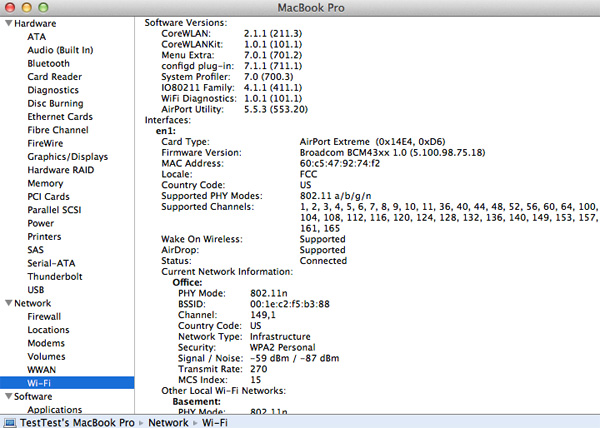


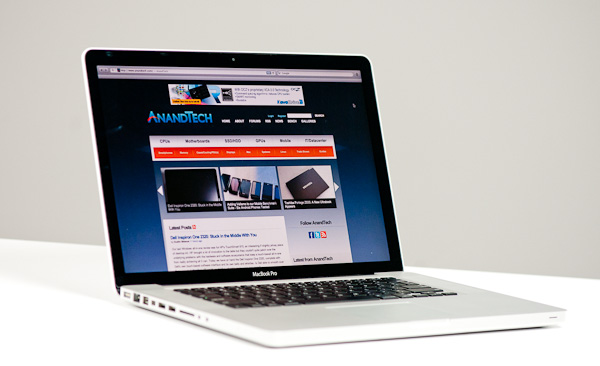








101 Comments
View All Comments
futurepastnow - Friday, November 18, 2011 - link
And 5400 RPM hard drives standard. Now that's a bad joke.It's also pretty sad that the 13" model still has a 1280x800 screen when Apple's own 13" Macbook air uses a 1440x900 display.
trifecta88 - Friday, November 18, 2011 - link
It could be because current benchmarks are being done on Lion and not Snow Leopardgrahamnp - Friday, November 18, 2011 - link
The 2.2 tested is the replacement for the old 2.0ghz which isn't shown in all the charts but when compared it does come out on top.name99 - Saturday, November 19, 2011 - link
You do realize that the 2.3 GHz model (early 2011) was the EXTREME HIGH END model (best of 2.0, 2.2 and 2.3GHz);the 2.2 GHz model (late 2011) is the LOW END model (worst of 2.2, 2.4 and 25)?
The article could do a better job of explaining that, I'll admit. But you (and even worse, some of the idiotitic followup commentators) could do a better job of not assuming something that is highly unlikely --- that Apple has DELIBERATELY chosen to reduce the performance of its machines, and that Anand is so in love with them that he thought this wasn't worth mentioning.
Better commenters, please.
loox - Sunday, November 20, 2011 - link
Wow... an off-topic, major PC vs Mac fanboy flame war on an Anandtech article re: an Apple product. That *never* happens. *yawn* They both have their place on this planet. Moving on...I'd like to remain on topic *gasp!* and return to the OP's observation:
I am confused, as well... is this a typo in the charts? or is my 15" early 2011 macbook pro really superior to the late 2011 in benchmarks... this is not making sense to me.
On the flipside, if true, it makes me very happy as I purchased the macbook pro for the video card, and am happy to see that I would not have lost much performance gain had I waited for the later 2011 model.
loox - Sunday, November 20, 2011 - link
I am seeing what I think may be the cause...In "early 2011" I purchased the higher end 15" Macbook Pro. At that time, the more expensive model came with the Radeon 6750 and a slightly higher clocked Core i7 SandyBridge (2.3 Ghz). It looks like this model was used in the charts above.
Meanwhile, the model that Anandtech benchmarks in *this* review, is the lower end (cheaper) 15" Macbook Pro which, in "late 2011" has the (1) the same Radeon 6750 GPU as the higher-end, early 2011 Model I have and (2) a slightly slower clocked Core i7 SB CPU (2.2 Ghz).
This explains alot.... had Anandtech tested the 2200 USD variant of the "late 2011" 15" MBP, it surely would have bested my 2200 USD variant of the "early 2011" 15" MBP because it would have benchmarked the higher-end Radeon 6770 and CPU in the 2200 USD MBP.
Basically, it looks like the hardware in my 2200 dollar MBP from early 2011 is now comparable to the hardware in the "late 2011"'s 1800 dollar MBP As a result, I would have waited 2 months had I known I could get pretty much the same hardware for 400 dollars less. But, hindsight is 20/20 and something better always comes along.
This does, however, explain the benchmark tables in this article. Had the higher end variant of the late 2011 MBP been used, the results would no doubt have favored the newer model.
ThreeDee912 - Monday, November 21, 2011 - link
After seeing those charts I knew someone was read it incorrectly and assume Apple is gimping their systems or something....The Early 2011 model is the *high-end* 15" upgraded to the optional built-to-order 2.3 GHz (2820QM) i7 with 8MB L3 cache.
It still ranks slightly higher than the newer model, because the new Late 2011 model in the charts is only the *low-end* stock 15" model with a 2.2 GHz (2675QM) i7 6MB L3 cache.
So the low-end 15" model is quite a bit faster than before, but still not as fast as the highest-end customized 15" model from a few months ago.
To exaggerate, it's like saying "Why is my old i7 still faster than this new Pentium?"
You can see the previous specs here in a neat chart here:
http://en.wikipedia.org/wiki/MacBook_Pro#Technical...
TheGeoff - Thursday, November 17, 2011 - link
It's been awhile since I've gotten to spend any time with this body style. Do they still have that sharp "wrist-cutter" edge on the front? That was a deal killer for me.Brian Klug - Thursday, November 17, 2011 - link
This is actually one of the more subtle things I've noticed with the newer MBPs.After MacBookPro6,2 the front edge on every MBP has received a very small bevel that makes a huge difference on the wrists. I have an 8,2 which has the bevel, so anything newer than 6,2 should likewise have it. It makes the difference between wrist-cutting and not right at the center thumb-notch area too (which used to come to a very sharp point on both sides).
-Brian
retrospooty - Thursday, November 17, 2011 - link
a 15 inch laptop with 1440x900 LCD, 2.2ghz quad core 4gb ram for $1800. I could literally get 2 equivalent ones for that price